Works Stage West Side Story (1957)
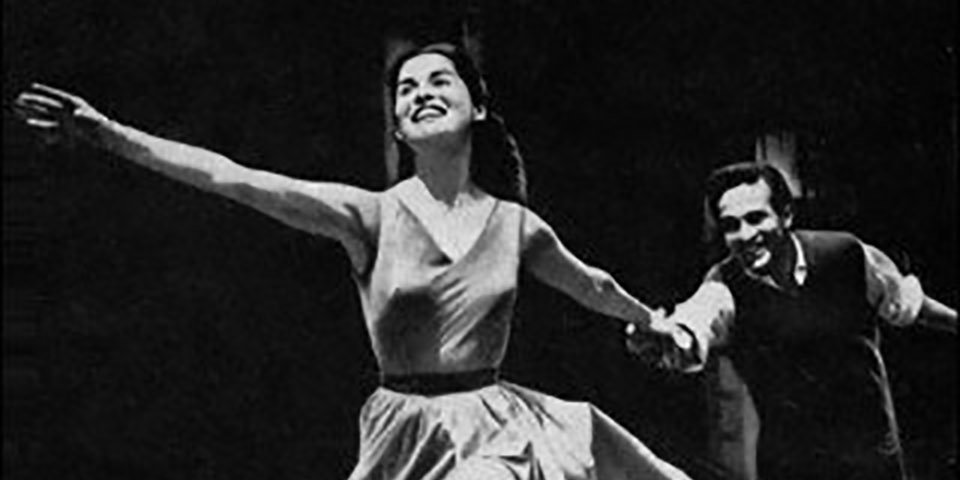
West Side Story Guide and Commentary by Jack Gottlieb
Story Sources
It is widely known that West Side Story (WSS) is based directly on Shakespeare’s Romeo and Juliet (R&J). Far less well known is the fact that Shakespeare based his play (1594) on other material, particularly a narrative poem by Arthur Brooke entitled The Tragicall Historye of Romeus and Juliet (1562). The theme of two lovers thwarted by circumstances beyond their control, however, had long before been established in Western legend: Troilus and Cressida, Tristan and Isolde, to name only two such pairs. In more recent times, American folklore had assimilated the myth into the feud between the Hatfields and McCoys. Brooke’s description of R&J as an "vnfortunate coople" displays a puritanical streak:
" . . . louers, thrilling themselves to vnhonest desire, neglecting the authoritie and aduise of parents and frendes."
Shakespeare transcended the question of morality, though he borrowed freely from the earlier poem, and in fact, he replicated Brooke’s actual words in at least three instances. But Brooke pales by comparison. Shakespeare rapturously expanded the soliloquies, and fashioned new personages endowing them with nobility.
Although there are many borrowings of plot and content from R&J to WSS, Arthur Laurents, author of the book for the musical, did not verbally borrow from Shakespeare. But just as Shakespeare transformed Brook’s "Drunken gossypes, superstitious friers, vnchastitie, the shame of stolne contractes hastyng to more vnhappye deathe," so Laurents replaces the second half of Shakespeare’s play, which he tells us, "rests on Juliet’s swallowing a magic potion, a device that would not be swallowed in a modern play." He continues:
"In the book (why are the spoken words for a musical show called this?) . . . the dialogue is my translation of adolescent street talk into theater: it may sound real, but it isn’t."
That he succeeded, and did so brilliantly, is attested to by his companion-in-arms Alan Jay Lerner:
"Arthur Laurent’s book, with its moving re-telling of the Romeo and Juliet tale. . . is a triumph of style and model of its genre. As a fellow tradesman, I was filled with the deepest admiration."
Jerome Robbins had at first envisioned Juliet as a Jewish girl and Romeo as an Italian Catholic. The action, set during the Easter-Passover season, was to have occurred on the Lower East Side of New York City. Hence the title might have been EAST Side Story. (Another working title was Gangway!) That was in 1949. Six years later, Laurents and Leonard Bernstein were working (independently) in Hollywood, where they conferred on the aborted project. The newspapers were filled with reports of street riots by Chicano Americans in Los Angeles.
Those headlines turned the trick, triggering the imaginations of the collaborators. The locale swiftly shifted to New York’s West Side, and in 1957 WSS exploded onto the American State. In the decades that have passed, WSS has become a contemporary classic.
The Operatic Trap
Soon after its premiere, Bernstein wrote about the lengthy gestation between the show’s conception and birth: "All the peering and agony and postponement and re-re-rewriting turn out to have been worth it." Part of that agony was the decision "not to cast ‘singers’: anything that sounded more professional would inevitably sound more experienced, and then the ‘kid’ quality would be gone."
Still, in 1949, Bernstein voiced apprehension of "making a musical that tells a tragic story in musical comedy terms . . . never falling into the ‘operatic’ trap" That trap must be the vise (as well as the vice) of vocal pyrotechnics for its own sake, without moving the story forward.
Bernstein does avoid that trap in WSS. For example, one of the most operatic moments is the duet between Anita and Maria: A Boy Like That/I Have a Love. This denouement is, in the words of Stearns: "Anita’s fateful change of loyalties from which the rest of the drama unfolds. " Bernstein evolves one song out of the other through a kind of musical legerdemain. Thus when Anita fulminates against the killings, we hear what will turn into Maria’s eloquence, using precisely the same pitches and almost the same rhythm. The seed has grown to tower over the ground in which it was planted.
While there is hope in WSS, there also is despair, and this too is reflected, in musical terms. Throughout the entire score the interval of the tritone is prominently displayed. (Theorists from the past have nicknamed the tritone Diabolus in musica (Devil in music"). It was considered the most "dangerous" interval. Its unstable, rootless quality (C, for example, to F# consists of three whole-steps, hence: tritone) was the perfect musical distillation of the unstable relationship between Tony and Maria, and for the rootlessness, and the resulting ruthlessness, of the Jet and Shark gangs.
Careers
Bernstein once said the show could not "depend on stars, being about kids." Hundreds of young hopefuls auditioned for the original production. Of the forty ‘kids’ who landed the jobs - - for most, their Broadway debut - - many went on to a wide variety of show business (or related) activities. Perhaps not all their pathways were to greater glory, but without WSS their careers would probably have taken considerably longer to blossom. Furthermore, some of them continued to maintain relationships with their WSS colleagues on a personal and/or professional basis.
The most astonishing career to be launched from the WSS pad was that of its lyricist, Stephen Sondheim, considered by many to be the most significant composer-lyricist of our time. If there is an indigenous American operatic style of today, Sondheim must be regarded as its standard-bearer. The operatic innovations introduced by the WSS creative quartet: broader song dimensions, simultaneities in complex counterpoint, etc. became grist to the Sondheim mill.
Symphonic Dances Form West Side Story was premiered by the New York Philharmonic on February 13, 1961, but the conductor was Lukas Foss. Bernstein was named Music Director of the Philharmonic one year after the opening of WSS, and although he later performed and recorded the Dances with the orchestra, he never, prior to the 1985 recording, conducted a performance of the show. (He was in the pit to conduct the so-called Overture - - a compilation of tunes not made by him - -for one of the early Broadway revivals). But why should someone whose career has been so diversified concentrate on one all-consuming project, a Broadway run? Bernstein never conducted a live theater performance of his Candide, Wonderful Town, or MASS, either.
His recording of On The Town, made long after its premiere with, among others, three of the original cast members, is the first show album ever to be put onto disc by its composer. But one historical first has yet to occur in the annals of recorded Broadway musicals: a full original cast album conducted by its composer.
The Film
The Academy Award for Best Picture of 1961 went to the movie version of West Side Story, earning a total of ten Oscars.
Although Bernstein did not suffer the indignity of the mayhem perpetrated on his score in the movie of On The Town, the movie of West Side Story did make some minor alterations. "I Feel Pretty" was transferred to an earlier scene, the bridal shop. The location of "Gee, Officer Krupke" was interchanged with "Cool". Sondheim also wrote new lyrics for "America", performed by all the Sharks and their girls (in the stage version it is presented by four girls only).
These changes were judged to be necessary to sustain an on-rushing sense of doom. After all, the movie was not interrupted by an intermission during which an audience could recover form the devastation wrought by the danced Rumble. On stage, the bubbly "I Feel Pretty", at the beginning of Act II, was a kind of extension of intermission babble.
The Dubbers
The singing voices of Richard Beymer (Tony, in the movie) was that of Jim Bryant, a Hollywood jazz and commercial arranger and bass fiddler, chosen because his singing timbre matched Beymer’s spoken sound. Similarly, Betty Wand, a mezzo-soprano, was hired to do some, but not all, of Rita (Anita) Moreno’s singing. Wand later sued to get a percentage of the movie-album sales, a dispute settled out-of-court. But the most convoluted dubbing problems were those for the voice of Natalie Wood (Maria).
Marni Nixon was employed on a day-to-day basis (no contract was signed) to do only the high or sustained notes that Wood’s less disciplined voice could not manage. And, indeed, the songs were recorded in that manner, with Wood being continually told how "wonderful" she was. While this was going on, Nixon was being told that she would do the full soundtrack, which was hard to believe under the circumstances. But this delicate and deliberate game of musical pawns was played to ensure there would be not clash between star and studio until Wood’s visuals had been completely filmed. When she was finally "in the can," Wood was informed that Nixon had been elected. Wood’s reaction was understandable anger, and later on when she filmed her role in Gypsy, no substitutions were made for her singing voice.
Nixon’s job then became much more complicated than her dubbing of Deborah Kerr in the filming of The King and I. There, everything had been carefully worked out in rehearsal, with Nixon physically next to Kerr at all music rehearsals. But since Wood had already been filled with musical inaccuracies, Nixon had to compensate for them. On long shots there was no problem, but on close-ups she had to hedge it one way or another. In fact, Nixon even dubbed Wood’s speaking voice at the very end: "Don’t you touch him!" Te adoro, Anton."
Due to the web of deception, Nixon felt she deserved a cut of the movie-album royalties. Neither the movie or the record producers would bow to her demands. Bernstein broke the stalemate by volunteering a percentage of his income, a gesture of loyalty-royalty since Nixon had been a performer-colleague of his at New York Philharmonic concerts.
© Copyright 2001 by Jack Gottlieb
All rights reserved. May not be used without permission.
LB100
Throughout the Leonard Bernstein Centennial, West Side Story continued its longtime success and popularity, with both theatre and opera companies worldwide giving over 1300 performances in 24 countries and 25 US States. The Centennial’s performances included exciting new productions from Opera Australia's Handa Opera on Sydney Harbour; Takarazuka Revue's all-female production in Japan; the Fugard Theater's in South Africa, the Guthrie Theatre's production in Minneapolis, the Komische Opera in Berlin and SOM Productions in Spain, to name only a few. In addition, the GRAMMY Awards paid homage to the composer at the 60th Annual GRAMMY Awards Ceremony with a performance of “Somewhere” from West Side Story by TONY and GRAMMY award-winning artist Ben Platt. The Centennial also brought with it the rare opportunity to introduce Leonard Bernstein to a new generation of young audiences and performers. The El Sistema-inspired music programs around the country shared in a special arrangement of the song “Somewhere” from West Side Story. Google paid tribute on the birthday with a delightful Doodle featuring an animated cartoon of LB set to the Prologue from West Side Story.
<iframe src="https://open.spotify.com/embed/playlist/1PrAx0UaHBSBtJfOIXjCH5?utm_source=generator" width="100%" height="380" frameBorder="0" allowfullscreen="" allow="autoplay; clipboard-write; encrypted-media; fullscreen; picture-in-picture"> </iframe>
*Book by Arthur Laurents, Lyrics by Stephen Sondheim;
Musical based on a conception of Jerome Robbins.
Music by Leonard Bernstein. ©1956, 1957, 1959,1962, renewed
Orchestra and Chorus conducted by Leonard Bernstein.
Maria - Kiri Te Kanawa; Tony - Jose Carreras;
Anita - Tatiana Troyanos; Riff - Kurt Ollman; Rosalia - Louise Edeiken;
Francisco - Angelina Reaux; Consuela - Stella Zambalis; Action - David Livingston;
Diesel - Marty Nelson; Baby John - Stephen Bogardus; A-rab - Peter Thom;
Snowboy - Todd Lester; Bernardo - Richard Harrell.
Dialogue: Nina Bernstein (Maria) - Alexander Bernstein (Tony).
℗1985 Polydor International GmbH, Hamburg.
Related Works
West Side Story film with live orchestra
Symphonic Dances from West Side Story
Related Content
IBDB Profile
Playbill Vault
Details
West Side Story exist in a number of arrangements suitable for concert performance. The "Symphonic Dances from West Side Story" is among the most performed orchestral works of the 20th century, and is consistently seen on programs worldwide.
Concert Suite No. 1 from "West Side Story"
(arr. 1992) 20 min
for soprano, tenor and orchestra
Concert Suite No. 1 contains arrangements of the following numbers: "Maria", "One Hand, One Heart", "Somewhere", "Balcony Scene".
- Scoring 2.1(=corA).3(III=bcl).1-2.3.2.0-timp.perc(2)-elec.guitar-pft(=cel)-strings(vln,vlc,db)
Concert Suite No. 2 from "West Side Story"
(arr. 1992) 15 min
for soloists (S,3M,T,2Bar), chorus and orchestra
Concert Suite No. 2 contains arrangements of the following numbers: "I Feel Pretty", "Jet Song", "America", "Tonight Quintet".
- Scoring
- Full version: 3(=picc).1.4(II=Ebcl,III=bcl,IV=asax).tsax.ssax(=bsax).1-2.3.2.0-timp.perc(4)-spanish guitar(=elec.guitar)-pft(=cel)-strings(vln,vlc,db).
- Alternate (reduced) wind version: 3(I,II,III=picc).1.3(I=Ebcl,III=bcl).asax(optional).2-2.3.2.0-timp.perc(4)-spanish guitar(=elec.guitar)-pft(=cel)-strings(vln,vlc,db)
Performance Notes: The two Concert Suites cannot be performed together. For orchestral concerts, an instrumental number from West Side Story, such as Symphonic Dances, can be played alongside with: either a) up to three individual songs from West Side Story, or b) one of the Concert Suites from West Side Story.
West Side Story Suite (arr. Paul Bateman, for Daniel Hope)
(arr. 2019)
for violin and string orchestra
West Side Story Suite (arr. David Newman)
(arr. 2011) 18 min
for violin and orchestra
- Scoring
- 2.2(II=hrnA).3(III=bcl).2(II=cbssn)-4.3.3.0-timp (=Pitched Drums, Timbales, Maracas).perc:bongos/tam-t/SD/BD/vib/cym/wdbl/xyl/glock/chimes/mark tree/antique cymb/choke cym/4 pitched drm/TD/finger cym/cowbell/timbales/guiro/temple block/maracas/tamb/trgl/ sus.cym/congas-harp-pft(=celesta)-strings
West Side Story Suite (arr. Lucien Plessner/Andreas Kowalewitz)
(arr. 2010) 22 min
for guitar and small orchestra
Scoring: solo guitar.fl-hn.flugel hn-perc(ad lib)-strings
Stock, amateur, and foreign productions of West Side Story
Please contact Music Theater International. Tel: (212) 541-4684
West Side Story School Edition
Please contact Music Theater International. Tel: (212) 541-4684
Concert performances of suites and individual numbers
Please contact Boosey & Hawkes, North America. Tel: (212) 358-5300
In the UK: Boosey & Hawkes, London. Tel: (020) 7580 2060
Reprint of music and lyrics
Please contact Boosey & Hawkes, North America. Tel: (212) 358-5300
In the UK: Boosey & Hawkes, London. Tel: (020) 7580 2060
Synchronization, mechanical and other media uses
Please contact Universal Music Publishing. Tel: (310) 235-4700
First-class licensing of West Side Story
Please contact The Leonard Bernstein Office, Inc. at:
The Leonard Bernstein Office, Inc.
121 West 27th St, Suite 1104
New York, NY 100001
USA
(212) 315-0640
Fax: (212) 315-1585
licensing@leonardbernstein.com
Licensing of the West Side Story trademark
Please contact The Leonard Bernstein Office, Inc. at:
The Leonard Bernstein Office, Inc.
121 West 27th St, Suite 1104
New York, NY 100001
USA
(212) 315-0640
Fax: (212) 315-1585
licensing@leonardbernstein.com
For general licensing inquiries, click here.
To purchase sheet music for songs and arrangements from West Side Story, please visit our store.
Media
Re-designed website
 VISIT WESTSIDESTORY.COM
VISIT WESTSIDESTORY.COM
Cover Art for the Original Soundtrack Recording of West Side Story
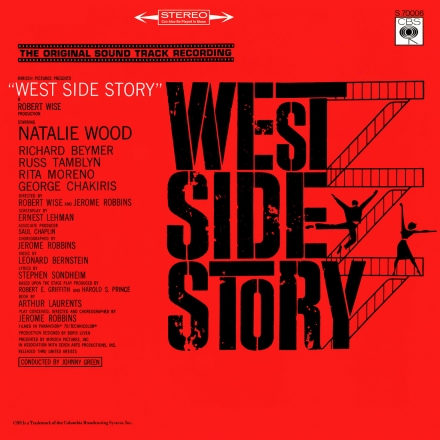 Columbia Records
Columbia Records
Cover Art for the Original Soundtrack Recording of West Side Story
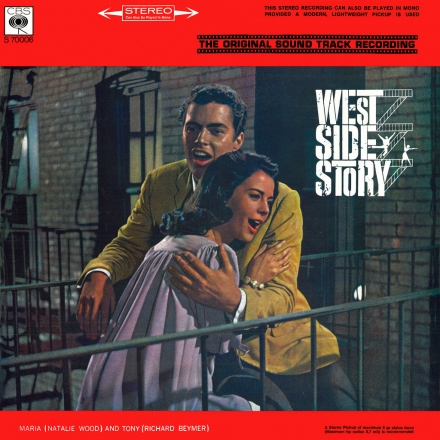 Columbia Records
Columbia Records
Bernstein at rehearsal for West Side Story. Carol Lawrence (who played Maria) is at his left, and lyricist Stephen Sondheim is playing the piano, 1957
 Library of Congress Digital Archives
Library of Congress Digital Archives
Leonard Bernstein at the opening of West Side Story at the National Theater, Washington DC, August 12, 1957.
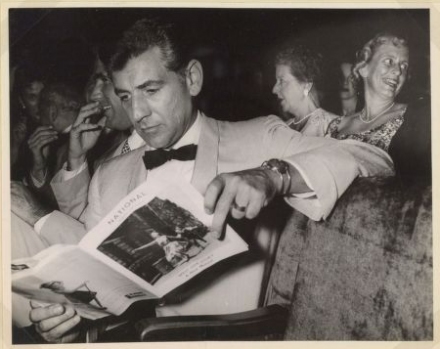 Library of Congress Digital Archives
Library of Congress Digital Archives
West side story : Somewhere manuscript sketch
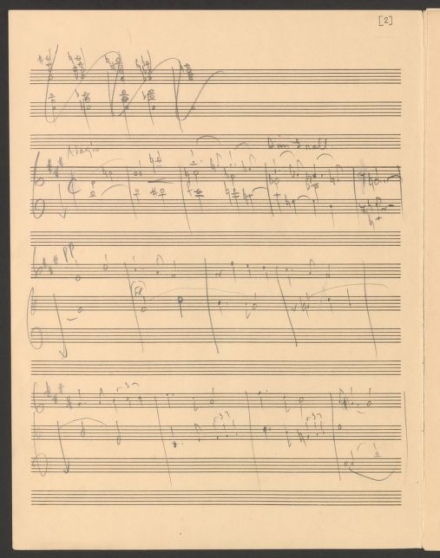 Library of Congress Digital Archives
Library of Congress Digital Archives
Carol Lawrence remembers West Side Story on Broadway, 1957
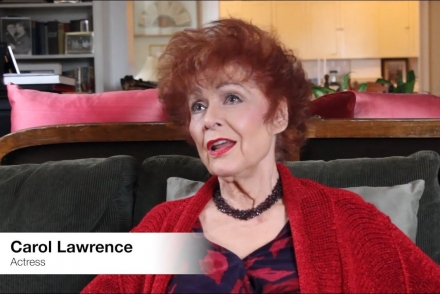
Audio
Review West Side Story at Glimmerglass Festival From "DC Theatre Scene" 2018 Review A New ‘West Side Story’ Steps Beyond Jerome Robbins From "American Theatre" 2018 Review West Side Story reminds us of Leonard Bernstein's brilliance From "Washington Examiner" 2022